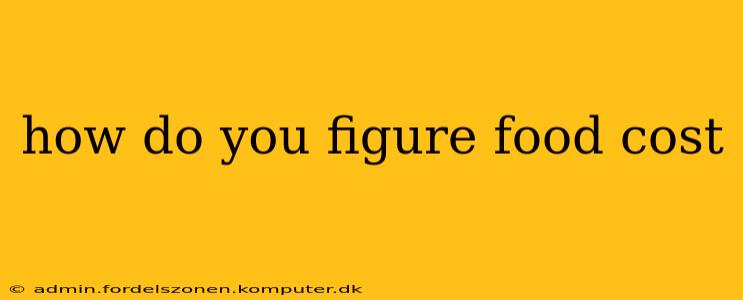How Do You Figure Food Cost? A Comprehensive Guide
Figuring your food cost is crucial for the success of any food service business, from a bustling restaurant to a small catering operation. Understanding your food cost percentage allows you to price your menu items profitably, manage inventory effectively, and ultimately, maximize your profits. This guide will walk you through the process, answering common questions along the way.
What is Food Cost Percentage?
Food cost percentage is a key metric that represents the ratio of your food costs to your food revenue. It's calculated as:
Food Cost Percentage = (Cost of Goods Sold / Food Revenue) x 100
Understanding this percentage is vital. A high food cost percentage indicates that your food expenses are eating into your profits, while a low percentage suggests efficient cost management and potentially higher profit margins. The ideal food cost percentage varies depending on the type of establishment and menu, but generally falls between 28% and 35%.
How to Calculate Food Cost: A Step-by-Step Guide
Calculating your food cost involves several steps:
-
Inventory: Regularly conduct physical inventory counts of all your food items. This is the most accurate method, though it can be time-consuming. Consider using a FIFO (First-In, First-Out) method to track inventory, ensuring you account for spoilage and waste.
-
Beginning Inventory: Record the value of your inventory at the beginning of a specific period (e.g., a week or a month).
-
Purchases: Keep detailed records of all food purchases during the same period. This includes invoices from suppliers and any other relevant documentation.
-
Ending Inventory: At the end of the period, conduct another inventory count to determine the value of your remaining food stock.
-
Cost of Goods Sold (COGS): This is the heart of the calculation. It represents the cost of the food you actually used during the period. The formula is:
COGS = Beginning Inventory + Purchases - Ending Inventory
-
Food Revenue: This is the total revenue generated from food sales during the chosen period. Exclude beverage sales, other revenue streams (like merchandise), and taxes.
-
Food Cost Percentage: Finally, use the formula mentioned earlier to calculate your food cost percentage:
(COGS / Food Revenue) x 100
What are the Different Methods for Calculating Food Cost?
While the above method is the most common, other methods exist, each with its own advantages and disadvantages:
-
Periodic Inventory Method: This involves taking inventory at set intervals (weekly, monthly). It's relatively simple but might not capture daily fluctuations in food costs.
-
Perpetual Inventory Method: This requires constant tracking of inventory levels using a computerized system. It provides real-time data but is more complex and expensive to implement.
-
Simplified Food Cost Method: This method is used for smaller businesses and involves estimating food cost based on previous periods' data. It's less accurate but requires less effort.
How Often Should You Calculate Food Cost?
Ideally, you should calculate your food cost regularly—at least monthly. This allows you to identify trends, address issues early, and make informed decisions about your pricing and purchasing strategies. More frequent calculations (weekly) are beneficial for smaller businesses or those with high turnover.
What Factors Can Affect Food Cost?
Numerous factors can influence your food cost, including:
-
Menu engineering: Carefully designed menus can optimize profitability by featuring high-profit items and minimizing the use of expensive ingredients.
-
Portion control: Consistent portioning minimizes food waste and ensures accurate cost tracking.
-
Supplier relationships: Negotiating favorable prices with reliable suppliers can significantly reduce food costs.
-
Waste management: Implementing strategies to reduce food waste, such as proper storage and inventory management, is crucial.
-
Seasonal variations: The cost of ingredients fluctuates throughout the year, so be aware of seasonal changes and adjust your menu accordingly.
By diligently tracking and analyzing your food costs, you can gain valuable insights into your business's financial health and make data-driven decisions to enhance profitability and operational efficiency. Remember to choose the method that best suits your business size and resources.
